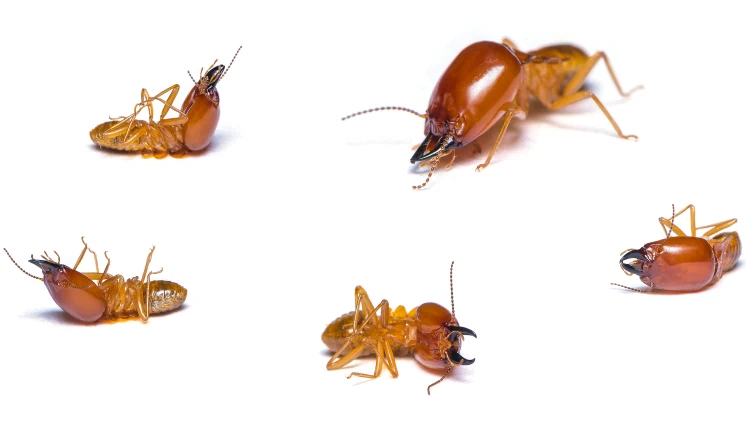Often, people mistake a termite infestation for ants. Between the two, termites can cause severe damage to your home and should be taken care of immediately. To tell them apart, check out our Ants and Termites page – but always call a professional for a second opinion.
Termites are insects that evolved from cockroaches and adapted to eat wood. They are one of the most prominent insects on Earth, found everywhere except Antarctica. Their colonies can range from a few hundred to several million termites. While termites typically feed on decaying plants, fallen tree branches, and tree stumps, they sometimes end up chewing on our homes instead. This can lead to severe structural integrity damage to property, making them one of the most expensive pests if left untreated.


While termites pose no direct threat to people and don’t transmit disease like other pests, the damage they cause to buildings makes them an incredibly dangerous pest.
The worst part is, most termites are able to enter a home silently and unseen. They make use of mud tunnels to stay “underground” at all times and if you don’t know what to look for, they can cause months or years of damage before you start to notice they are even there. That’s why the best thing you can do if you suspect you may have termites is call Etheridge Pest Services and perform a thorough termite inspection.
Tips for preventing Termites
Termites are drawn to wood. Any wood that comes in contact with soil is at risk of being found by these underground dwelling insects. Wooden beams that go into the ground can be an easy access to food for the termites, as well as a hidden entryway into your home. Posts that go into a concrete foundation are still at risk, as most posts drive through the concrete down to soil.
Never store firewood or wooden debris near your home, under decks, or in any crawl spaces. Have a dedicated spot away from your home to store collected wood. This goes for other wood-based materials like cardboard boxes and newspaper.

Do not let moisture accumulate near the foundation of your home. Wood that stays wet is more likely to attract termites. All water should be diverted away from the foundation using gutters and splash blocks. Leaking pipes and AC units should be repaired to prevent them from being a free source of water to termites (and other pests). It also helps if the ground slopes away from your foundation. Lawn sprinklers should be positioned in a way that prevents spraying too close to your home.
Having decorations or plants that touch your home can act a bridge for pests to avoid insecticide treated soil. If you have plant vines, ivy, or dense bushes near your home, consider trimming them to prevent making it easy for termites to find a safe way into your home.
Use mulch sparingly. Many people prefer using mulch beddings for their property as it is aesthetically pleasing, however the moisture retaining elements of mulch strongly attract termites. The mulch itself isn’t even of much nutritional value to the termites, but having a source of moisture and insulation from weather give termites a great spot to hide. If you do use mulch, make sure it does not come into contact with wooden sidings or any basement windows. Crushed stone is a preferred alternative to mulch.
The best thing you can do to prevent termites is have your home treated by a professional with a year-long solution and schedule an annual maintenance and inspection. The risk of a termite infestation is too costly to go untreated. It is always easier to prevent structural damage than to have to repair the damage termites can cause. Visit our Termite Control Services page to learn more.
